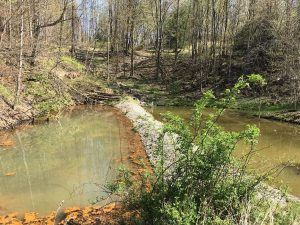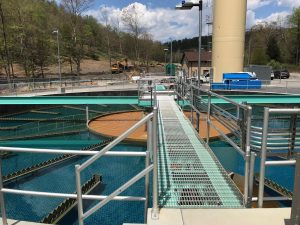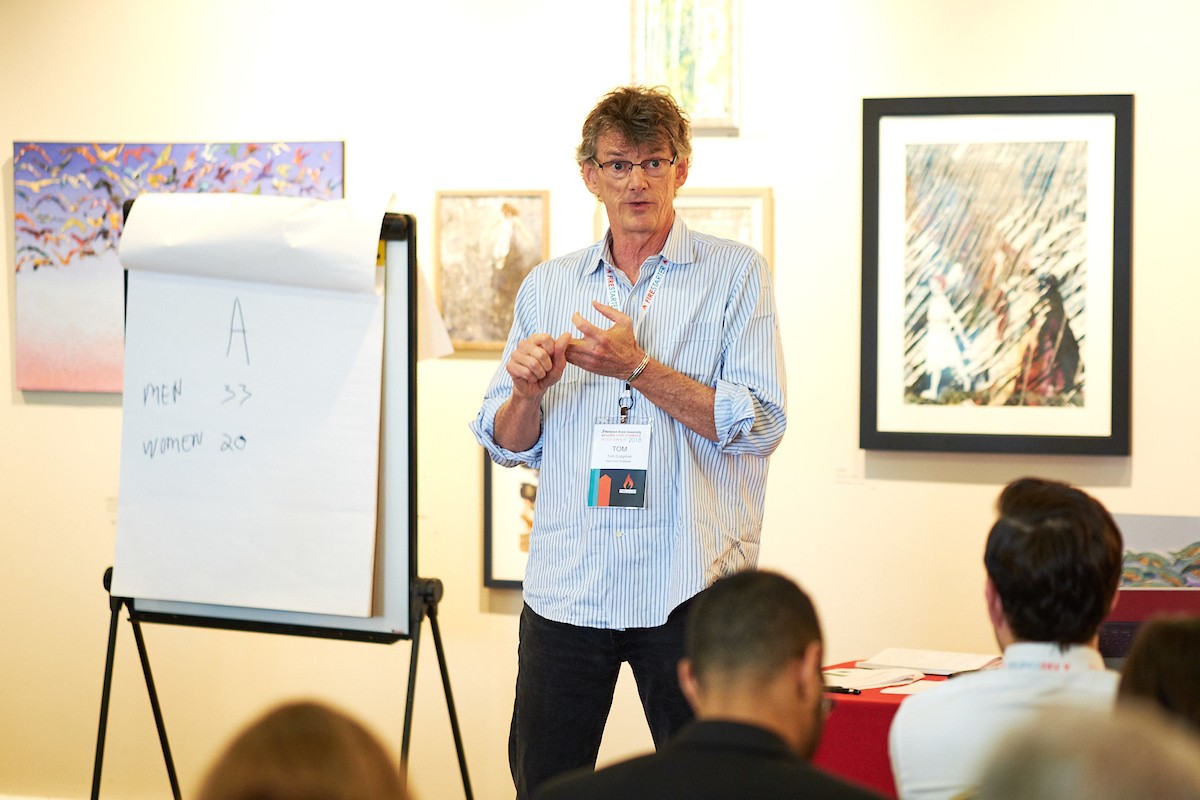On a recent sunny Wednesday, Paul Ziemkiewicz, director of West Virginia University’s Water Research Institute, was standing on a bridge looking out at Big Sandy Creek. It was a balmy afternoon, perfect for kayaking, and the creek running the Cheat River was clear. But 25 years ago, this water was a shocking orange color — from acid mine drainage.
Look at this,” Ziemkiewicz said, gesturing to the raging water below. “This is a fishery now, but it was completely dead back then.”
This year the last heavily-polluted stretch of the watershed is set to be cleaned up.
“In my lifetime a river that was dead has now come back,” said Amanda Pitzer, executive director of Friends of the Cheat, a local conservation group that was formed by a motley crew of river guides and enthusiasts in 1994 to deal with acid mine pollution. The group also hosts the annual Cheat River Festival to celebrate the river and raise money to restore it.
The Cheat was known to be polluted for decades, but the pollution grabbed national attention after two blowouts at the active T&T coal mine in 1994 and 1995 poured millions of gallons of acidic water into the main stem of the Cheat. Fish were killed 16 miles downstream in Cheat Lake.

More than two decades later, Friends of the Cheat, local residents and businesses and state and federal regulators have a reason to celebrate: Once fully operational, an active water treatment plant run by West Virginia Department of Environmental Protection near the T&T mine will clean polluted water currently running through Muddy Creek.
Once the 3.4-mile stretch of Muddy Creek is clean, fish will be able to travel the entire length of the Cheat River — one of the longest free-flowing rivers in the eastern United States — unimpeded by pollution.
“It was such an accomplishment to bring the Cheat back, but to bring Muddy Creek back — I mean we’re kicking ass and taking names,” Pitzer said.
A New Approach
This success is largely the result of a decision among regulators, scientists and a local conservation group to treat the pollution problem as an entire watershed.
Across the Cheat River’s 1,422-mile watershed, more than 340 abandoned coal mines feed pollution into the Cheat and its tributaries, like the Big Sandy. Acid mine drainage, or AMD, is one of the largest contributors of pollution to thousands of miles of rivers and streams from Alabama to Pennsylvania.
The bright orange, and sometimes milky white, pollution contains iron, aluminum and manganese. It forms when pyrite, a mineral buried deep underground with coal, is exposed to air and water.
State regulators have limited federal dollars to ensure water coming from these mines meets federal Clean Water Act standards. An estimated 300,000 abandoned mines dot Appalachia, complicating the problem. Water that comes from mines built before 1977, when the Surface Mining Control and Reclamation Act went into effect, must be treated by the state. The law mandated that mines built after 1977 must be bonded, or have insurance, in case they go out of business or the operator chooses to stop maintaining the site. If that happens, DEP takes the money from those bonds and must reclaim the land and treat the water from these so-called “bond-forfeiture” sites.
Ziemkiewicz, of WVU, said originally in the Cheat River watershed — as is the case in many places dealing with AMD across Appalachia — regulators tried to address the problem by treating each individual mine contributing pollution to the river. But it’s not always effective.
“You can throw almost infinite amounts of money trying to treat point sources like that in a watershed like this that has both abandoned mines and also bond forfeiture sites and not make any impact at all on the quality of the stream because the abandoned mines dominate the whole picture,” he said.
A key piece to making this new approach work was some innovative thinking on the part of state regulators. The state DEP created an alternative clean water permit, which allowed the agency to address stream-wide water quality, rather than treat individual pollution sources.
“The watershed scale strategy that DEP is using here actually restores the creek and for a lot less money,” Ziemkiewicz said.
Scientists also needed to show federal regulators they could get results treating AMD pollution on a watershed level.
A Testbed in the Watershed

Standing in a grassy clearing overlooking this forested valley, it’s just possible to see the entry to a now-abandoned coal mine here in the headwaters of Sovern Run, a tributary of Big Sandy Creek, which runs into the Cheat.
Ziemkiewicz and his team built what’s called a “passive treatment” system. At Sovern site No. 62, AMD pollution flows through a series of limestone-lined ponds and channels. The alkaline limestone turns low pH, acid water coming out of the mine into much cleaner water through naturally-occurring chemical reactions. Passive systems don’t require power or the addition of chemicals and are often lower maintenance.
“We were able to knock off something like 80 percent of the acid load, most of the iron,” Ziemkiewicz said, of the passive treatment system. “The idea was to put a lot of these all over the watershed.”
During the first Cheat Fest in 1995, Friends of the Cheat and Ziemkiewicz and his team took federal officials from the Interior Department and Office of Surface Mining the treatment system at Sovern site No. 62.
The strategy being employed in the Cheat River watershed could be valuable to other communities struggling with AMD pollution. To help widen the scope, the Office of Surface Mining Reclamation and Enforcement created a federal plan inside its acid mine drainage program that allowed states to dole out federal Abandoned Mine Land dollars to local government agencies and watershed organizations, like Friends of the Cheat, to clean up streams impaired by acid mine drainage.
Friends of the Cheat took it and ran with it. They installed more than a dozen passive treatments. Today, they maintain those and a series of active treatments, or engineered systems. Active treatments include in-stream dosers, which deposit a steady stream of alkaline lime to help neutralize the water. Active treatments also include things such as water treatment plants.
Toddi Steelman, one of the founding members of Friends of the Cheat, studies watershed restoration She said the collaboration between Friends of the Cheat and regulators at both state and federal levels has been a 25-year experiment.
“Having the university close by and invested was a huge stroke of luck,” she said. “Having several sources of financial support in the 90s has really been essential.”
She also underscored the importance of having a local conservation group that is deeply invested in seeing the restoration of a river come to fruition.
“You need a local champion that is going to see it through because it’s really a labor of love,” she said. “It’s really about love the land, love of the river, love of community and I would say that’s really what has really characterized the group over time.”
This type of grassroots model can be a template for others, according to Scott Hardy, with the Ohio Sea Grant program at Ohio State University.
He studies collaborative watershed management and said the federal government moved toward providing resources for more grassroots, collaborative watershed restoration in the 1990s, with plenty of success stories.
Hardy said although collaboration can take longer than traditional top-down restoration efforts, having local groups that are passionate about their watershed helps.
The Last Piece
It takes a lot of heart, but it also takes a lot of money to clean a watershed.
Since 2000, the Environmental Protection Agency has contributed more than $5 million to the Cheat watershed. The state DEP has spent more than $13 million constructing and maintaining treatment systems across the area.
Now, one of the last treatments is almost in place. Once fully operational, a water treatment plant near the T&T mine will take care of the last major polluted stretch of the watershed.
You can see the T&T Treatment plant just off Route 26 near Albright. In some ways, it can best be described as a dishwasher for dirty mine water.
The plant will process AMD polluted water from three abandoned mine sites. Water pumped in from the polluted Fickey Run, will also be piped to the plant, said Larry Riggleman, the regional engineer for northern region of DEP’s Office of Special Reclamation.

Riggleman helped design the plant. It can treat between 800 to 4,200 gallons of polluted water each minute. A lime slurry is added to the two 80-foot tanks, or clarifiers, as they’re called. When the lime is added the iron and aluminum to drop to the bottom. The metal sludge is pushed to the middle, drains out, and is pumped back into the T&T mine nearby.
“And then from here it’s a straight discharge to the river,” Riggleman said.
If another mine blowout were to happen similar to the events in 1994 and 1995, the plant can handle up to 7,600 gallons per minute, which will flow through the two tanks and come out the other side clean.
The site cost about $8.5 million to construct and $30,000 a month to run, funded in part by the bond forfeited by the T&T mine. DEP also received support from oil and gas company, Southwest Energy. The company has a policy to offset its water use by contributing in other water restoration efforts.
“Within West Virginia we were looking for meaningful projects that were out there that we could be a contributor towards and the Cheat River is a beautiful river and one that stood out to us as a place that we could make a positive impact,” said Rowlan Greaves, manager of strategic solutions for Southwestern Energy.
Riggleman has been working in this watershed for years and he said once the plant is fully operational, Muddy Creek, which has been the single largest contributor of acid mine drainage for years, will be clean. He said it’s hard to quantify what that will mean.
“I mean, to be able to bring a stream back to life — which I can’t tell you when the last time it was it had a life — but from an environmental standpoint on the Cheat it’s huge,” he said. “I think from a recreational standpoint with people wanting to fish, kayak, things of that nature, I think that’s huge. I think it’s very important that this gets done and I think it’ll be very successful.”
Paul Hart, president of local rafting company, Cheat River Outfitters, agrees that the work done over the last two decades has made a difference in the water quality of the river. Today, he said, guides will often catch fish in the clear, clean water.
“A lot of people have seen it and decided ‘you know we can do better,'” he said. “And they’ve put their heads together and made it happen, which is a dream turned into a reality. The Cheat is just too much of a gem to be lost to something like acid mine drainage, it really is.”
But Hart added the river was already losing appeal as a rafting destination before the big mine blowouts in the 90s, and it has yet to recover. Pitzer, with Friends of the Cheat, said they recognize overcoming a polluted reputation takes time.

“Just like anything it takes time to change people’s perception of what a river is,” she said. “If you came here in the 80’s and you paddled the river and you remember it being orange and awful and then someone tells you ‘oh my gosh, I went and I caught walleye down in Jenkinsburg,’ they might be like ‘oh, get out of here’ you know. So, I think it just takes time.”
The groups plans to continue working to restore the river in the hopes that one day the Cheat has a different reputation: One of a clean, beautiful river.
This article was originally published by West Virginia Public Broadcasting.



